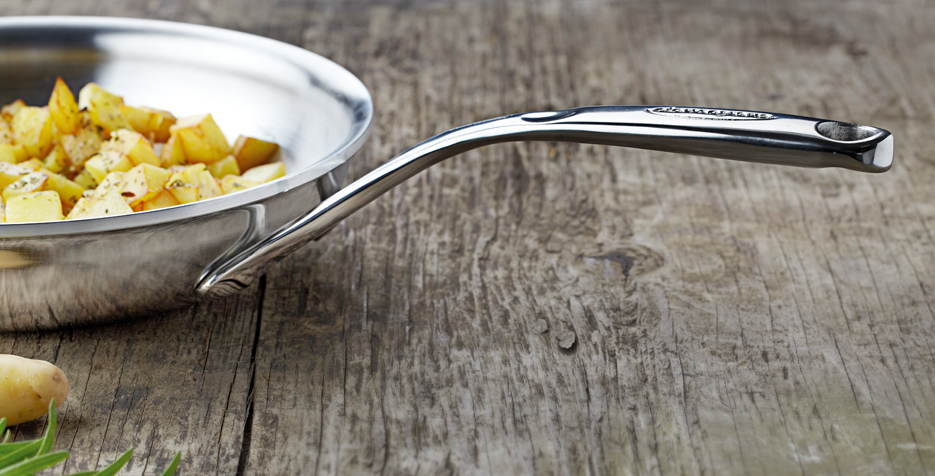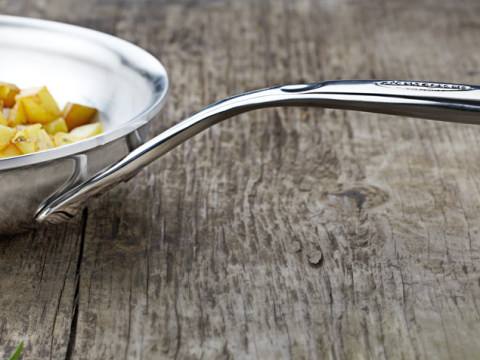The Truth About Frying Pans – Which Materials Are Best for Cooking
When buying a new frying pan, you’re bombarded with marketing claims and brands promising “magic” pans that do it all. While every professional chef has their favorites, one thing is certain: there’s no such thing as a perfect pan. Whether it’s a classic cast iron skillet, an aluminum pan, or stainless steel, or if you’re stuck in the never-ending non-stick vs. Teflon debate, every material has its pros and cons.
Key Factors to Consider When Choosing a Frying Pan
- Thermal conductivity – essential for even cooking
- Durability and strength
- Reactivity – some metals react with food and alter flavor
- Maintenance needs
- Price
Cast Iron Pan
Best for: Searing, frying, baking
Suitable for: Stovetop, oven, broiler, open flame
Cast iron is incredibly durable and retains heat very well, making it ideal for high-heat cooking. However, it’s heavy and requires proper seasoning to stay non-stick. It’s not great for cooking acidic foods slowly, but it can last a lifetime if cared for.
Pros:
- High heat retention
- Versatile – stove, oven, fire
- Non-stick when seasoned
- Extremely durable – can last generations
- Compatible with all utensils, even metal
Cons:
- Uneven heating unless preheated properly
- Requires careful maintenance
- Very heavy
- Reactive with acidic foods
Enameled Cast Iron Pan
Best for: Slow cooking, braising, baking
Suitable for: Stovetop, oven
All the benefits of cast iron without the hassle of seasoning. The enamel coating prevents reactions with acidic foods and offers an easy-to-clean surface. They come in stylish colors but tend to be pricier.
Pros:
- Non-reactive coating – safe for acidic foods
- No seasoning needed
- Excellent heat retention
- Durable and aesthetically pleasing
Cons:
- Less non-stick than traditional cast iron
- Heavy
- More expensive
Aluminum Pan
Best for: Sautéing, quick frying
Suitable for: Stovetop, oven
Aluminum offers excellent heat conductivity and is lightweight. However, it’s reactive with acidic foods unless coated or anodized. Premium brands often layer multiple materials for performance and durability.
Pros:
- Excellent heat conductivity
- Scratch-resistant coatings
Cons:
- Reacts with acidic foods if uncoated
- Not always dishwasher safe
Stainless Steel Pan
Best for: Sautéing, searing, making sauces
Suitable for: Stovetop, oven, broiler
Stainless steel is durable, non-reactive, and easy to maintain. However, it has poor heat conductivity unless combined with other materials like copper or aluminum. Look for 3-ply, 5-ply, or 7-ply for better performance.
Pros:
- Non-reactive and durable
- Dishwasher safe
- Affordable (in single-layer form)
Cons:
- Poor heat distribution without layered construction
- Multi-layer pans can be expensive
Carbon Steel Pan
Best for: Frying, sautéing, caramelizing
Suitable for: Stovetop, oven, broiler
Like cast iron, carbon steel needs seasoning. It heats up quickly and evenly and is lighter than cast iron. It’s ideal for high-heat cooking but can corrode if not properly maintained.
Pros:
- Natural non-stick surface
- Lighter than cast iron
- Fast temperature response
- Long lifespan
Cons:
- Requires regular seasoning
- Not suitable for acidic foods without seasoning
- Can rust if not cared for
Copper Pan
Best for: Searing, flambéing, sauces
Suitable for: Stovetop, oven, broiler
Copper offers the best thermal conductivity. It heats up and cools down rapidly, offering precision. However, it reacts with food and is often lined with stainless steel. It’s pricey and can dent easily.
Pros:
- Unmatched heat conductivity
- No need for long preheating
- Beautiful aesthetic
Cons:
- Reacts with food unless lined
- Expensive
- Soft metal – prone to dents
Non-Stick (Teflon) Coated Pan
These pans are made of various metals coated with PTFE (commonly known as Teflon). They’re great for low-fat cooking and easy cleanup, but the coating can degrade at high temperatures. Avoid metal utensils and overheating.
Pros:
- Food doesn’t stick
- Requires little or no oil
- Easy to clean
Cons:
- Short lifespan
- Coating can degrade with high heat
- Can release harmful fumes when overheated
Ceramic Coated Pan
These are metal pans with a ceramic non-stick coating. They’re considered a healthier alternative to Teflon, with a non-reactive surface suitable for acidic and alkaline foods. Lifespan and non-stick performance can vary by brand.
Pros:
- Non-reactive and safe for all foods
- Non-stick cooking surface
Cons:
- Durability varies
- Usually not suitable for high-heat searing


